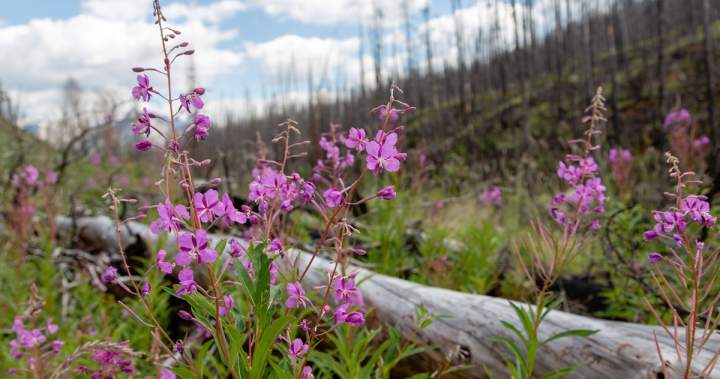I pause at the trailhead where, just a year ago, flames tore through Jasper National Park with ruthless efficiency. Today, the scent of fresh pine mingles with the lingering char as I follow ecologist Brenda Shepherd along a newly cleared path. The blackened trunks stand like sentinels, but between them, improbably bright green shoots push through the scorched earth.
“This is exactly what we want to see,” Shepherd says, kneeling beside a cluster of fireweed, its purple flowers nodding in the mountain breeze. “These early colonizers are nature’s first responders.“
Last July’s catastrophic wildfire consumed nearly 40,000 hectares of forest and forced the evacuation of thousands from the town of Jasper. It destroyed buildings, threatened crucial infrastructure, and transformed beloved landscapes into what many visitors described as a “moonscape.” Now, in summer 2024, we’re witnessing what fire ecologists have long understood but what feels miraculous to the untrained eye: the forest is already beginning its centuries-long journey of renewal.
“People see destruction, but what we’re observing is actually a natural process that’s been happening in the Rocky Mountain ecosystem for thousands of years,” explains Dr. Ellen Whitman, a fire research scientist with the Canadian Forest Service. “These lodgepole pine forests evolved with fire. They need it.“
The truth of her words is evident in the tiny pine seedlings sprouting across the forest floor. Lodgepole pine cones are serotinous – they remain sealed with resin until intense heat melts it away, releasing seeds specifically adapted to colonize fire-scorched landscapes. It’s a perfectly choreographed ecological dance that evolved long before humans drew boundaries around this UNESCO World Heritage Site.
Parks Canada has taken a measured approach to post-fire management, focusing primarily on critical infrastructure, trails, and areas where visitor safety is concerned. Unlike commercial forests where salvage logging and immediate replanting might be standard practice, much of Jasper’s burned areas are being left to recover naturally – a process scientists are closely monitoring.
“We’re collecting baseline data that will inform management decisions for decades,” says Cameron Eckert, a Parks Canada fire management specialist. “The opportunity to study a large-scale fire in a protected area gives us invaluable insights into climate adaptation strategies.”
For the town of Jasper, the recovery has been more complicated. Tourism, the lifeblood of the local economy, took a significant hit. Many businesses reported revenue losses of 30-50% in the months following the fire, according to a survey conducted by the Jasper Park Chamber of Commerce. But this summer has brought a cautious optimism.
“We’re seeing a different type of visitor this year,” says Elena Souchko, who owns a small tour company in Jasper. “People are coming specifically to witness the recovery. They want to understand what happened and how the landscape is changing.”
This phenomenon of “recovery tourism” is being embraced by local businesses and Parks Canada alike. New interpretive programs focus on fire ecology and forest renewal, while guides like Souchko have developed specialized tours highlighting the dramatic contrasts between burned and unburned areas.
For the Jasper Indigenous Forum, which represents over 25 Indigenous communities with traditional connections to these lands, the fire has sparked renewed conversations about traditional ecological knowledge and land management practices.
“Our ancestors used controlled burning as a stewardship tool for thousands of years,” explains Keith Diakiw, a member of the forum. “This catastrophic fire is partly the result of a century of fire suppression that interrupted natural cycles and traditional practices.”
The forum has been working with Parks Canada to incorporate Indigenous perspectives into recovery planning, including discussions about potential prescribed burns in strategic areas once conditions permit.
Wildlife response to the fire has been complex and varied. Large mammals like elk and deer initially fled the flames but have returned to browse on nutritious new growth. Moose populations may actually increase in the coming years as shrubby vegetation flourishes in open areas. For some species, however, the outlook is more concerning.
“We’re particularly worried about woodland caribou,” says wildlife biologist Dr. Lalenia Neufeld. “Their habitat was already fragmented, and the fire affected some important winter range.” Jasper’s caribou herds, already endangered, face new challenges as their recovery strategies are reassessed in light of habitat changes.
Birds tell a different story. Species that depend on standing dead trees, like woodpeckers, are thriving in the burned forest. The northern flicker, a large woodpecker species, has become noticeably more abundant as it feasts on insects in fire-killed trees and excavates nesting cavities that will later be used by other wildlife.
The fire’s impact extends beyond visible wildlife to the very soil beneath our feet. Research published earlier this year in the Canadian Journal of Forest Research suggests that high-intensity fires can alter soil chemistry and microbial communities for decades. At severely burned sites in Jasper, soil scientists have documented concerning levels of hydrophobicity – a condition where soils temporarily repel water rather than absorbing it.
“This can increase erosion risk and slow vegetation recovery in some areas,” explains Dr. Suzanne Simard of the University of British Columbia, whose pioneering work on forest underground networks has revolutionized our understanding of forest ecosystems. “But even this will resolve with time.”
As we reach a viewpoint overlooking the valley, Shepherd points to the mosaic pattern of the burn. Some patches are severely charred while others remain mysteriously untouched – islands of green in a sea of black. This variability, she explains, is ecologically valuable, creating diverse habitats that support a wider range of species.
“A uniform forest of trees all the same age is actually less resilient than this mosaic we’re creating,” she says. “In some ways, this fire is setting the stage for a healthier forest in the future.“
Climate change looms large over Jasper’s recovery. Rising temperatures and changing precipitation patterns are expected to make catastrophic fires more frequent throughout western Canada. According to Environment and Climate Change Canada, the annual area burned by wildfires in Canada could double or even triple by the end of this century if current emission trends continue.
For Park Manager Alan Fehr, the Jasper fire has been both devastating and instructive. “We’re learning lessons that will help us adapt to a changing climate,” he says. “This is forcing us to think differently about what it means to protect a national park in the 21st century.”
As the sun begins to set over the valley, painting the blackened landscape in gold, I notice something I missed earlier – mushrooms pushing up through the ash. These fungal pioneers are reconnecting the living network underground, breaking down dead material and making nutrients available to new plants.
In their quiet persistence, I find a metaphor for Jasper itself – a community and ecosystem finding pathways forward after devastation, transforming what was lost into something new. The recovery will unfold over generations, but already, life is returning to Jasper National Park, reminding us of nature’s remarkable capacity for renewal.






